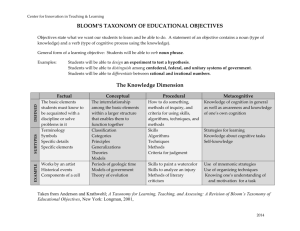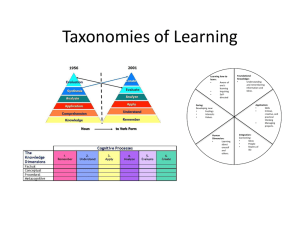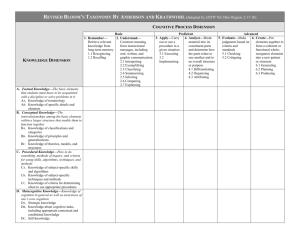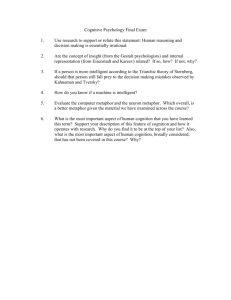An Assessment PowerPoint by Anne Fay
advertisement
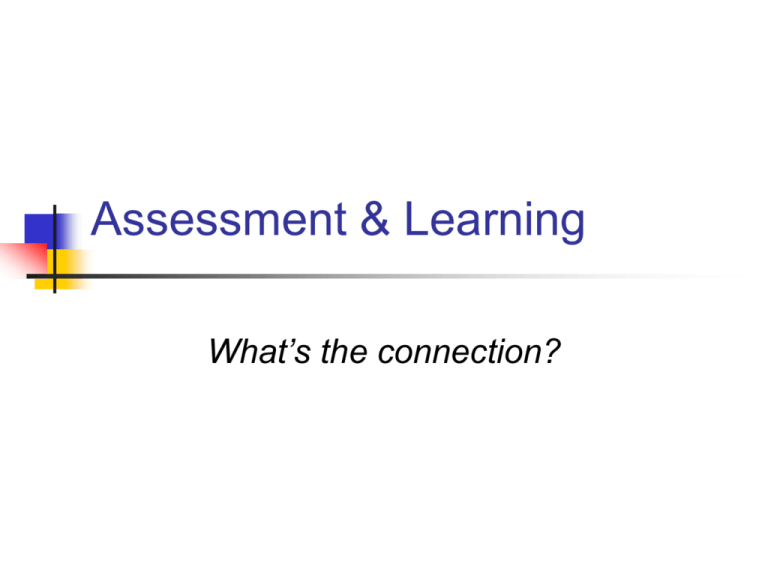
Assessment & Learning What’s the connection? A coin is tossed into the air and follows the path shown in A. Disregarding any effects of air resistance, in which diagram (B or C) do the arrows correctly represent the forces acting on the coin on the a) upward and b) downward parts of its trajectory? a a A b b B C What’s your best guess? What percentage of high school physics graduates get the problem correct? 12% What percent of students successfully completing their first semester of college physics get the problem correct? 28% What percent of students successfully completing a second semester of college physics get the problem correct? 30% What do you do when your class performs poorly on a test? Adjust the scores upward. Grade on a curve. Adjust the difficulty of the next assessment. Give advice on study strategies. Long for the “good old days” Provide more practice problems, review. Spend more time on the material in the future. Change your teaching materials or approach. How do you know what to change in your instruction? • Integrating assessment into the instructionlearning cycle can help us determine: • • • • If learning failures have occurred Why learning failures have occurred, What an effective course of action might be Whether our action has been effective. What does assessment have to do with learning? Good assessments provide opportunities for students to both learn and reveal their learning. All learning requires feedback but the feedback must be informative. - Feedback must provide guidance to the student and the instructor on what to do to improve performance. Learners must learn how to use feedback to improve performance Grades or scores help professors and students monitor learning, but they do little to promote learning What does Assessment have to do with Instruction? Instruction-Influenced Assessment Objectives Instruction Assessment Often we don’t have a clear vision of what or how we will assess until after we have designed or completed instruction. Assessment-influenced Instruction Formative Assessment Objectives Instruction Assessment Advantages of the Assessment-influenced Instruction • Accurate task analysis • Helps us pinpoint the knowledge and skills that need to be addressed. • Relevant practice activities • Helps us to design guided and independent practice activities that are better aligned with desired outcomes. • Lucid Expositions • Helps us provide clearer explanations to students regarding the purposes and goals of the instructional and assessment activities. The Assessment Triangle Observation Interpretation Methods & tools to reason about observations (both formal and informal) Tasks, situations for students to practice & demonstrate their knowledge & skills Cognition Theories of learning Knowledge & skills of domain National Research Council (2001). Knowing what students know: The science and design of educational assessment. National Academy Press: Washington:DC. Observation Interpretation Cognition What skills and knowledge are required and valued in my domain? How do the knowledge and skills develop? What is the trajectory from novice to expert? Are there popular misconceptions students possess? Are there consistent points of difficulty Are there prerequisites that students may not have How are these domain skills combined with general skills? Problem solving skills (planning, decomposition, result checking, etc) when faced with a complex project or assignment. Observations Interpretation Cognition What activities will enable students to demonstrate, practice and extend their skills and knowledge? How will I identify varying levels of competency? What would characterize & differentiate Will the feedback on their performance be informative and supportive of their learning? excellent performance? Why? competent performance? Why? unacceptable performance? Why? Grades are not very informative or supportive! Will the feedback on their performance be informative to my instruction? Observations Interpretation Cognition How will I interpret the observations? Informal, intuitive or qualitative Rubrics: Explicit characteristics of different levels of work Norm or Criterion Referenced Item analysis & Rule analysis Frequencies & Patterns of correct and wrong answers All good assessment connects these 3 components Interpretation Observations Cognition Every assessment: •Is based in a “theory” of how people learn, what they know and how knowledge and skill progresses over time •Embodies assumptions about which tasks are most likely to elicit demonstrations of what students know and can do. •Is based on assumptions about how best to interpret the outcomes to draw meaningful inferences about what students know and can do. Example from Physics Interpretation (Item Analysis) Observations A block on a scale weighs 10lb. If the scale and the block are covered and sealed & all the air is removed, how much will the block weigh? Why? Cognition Prior belief - Air pressure affects weight of objects 45%: it will weigh less because no air pressing down on it. 25%: it will weigh more because no air under scale holding it up. 30%: it will weigh the same because the removal of the up & down force of air pressure balance out Integrating & Aligning Instruction & Assessment Bloom’s taxonomy* Knowledge Dimension Factual -basic elements or components of domain needed to solve problems in it Conceptual - interrelationships among elements, how they function Procedural - how to do task, methods of domain, criteria for using skills, techniques, methods, etc Meta-cognitive - knowledge of cognition, such as how strategies can help, requirements of different tasks, & awareness of one’s own cognition, such as strengths, weaknesses, etc *Anderson, L.W., & Krathwohl, D.R. (2001). A taxonomy for learning, teaching, and assessing: A revision of Bloom’s taxonomy of educational objectives.Longman: New York, NY. Cognitive Processes Dimension Remember - recall, recognize, identify Understand - interpret, exemplify, classify, infer, summarize, explain, compare Interpret - clarify, paraphrase, translate, represent Apply - execute, implement, use, carry out Analyze - differentiate, distinguish, organize, attribute, select, parse Evaluate - check, critique, judge, monitor, test Create - generate, plan, produce, construct, hypothesize *Anderson, L.W., & Krathwohl, D.R. (2001). A taxonomy for learning, teaching, and assessing: A revision of Bloom’s taxonomy of educational objectives.Longman: New York, NY. Cognitive processes Knowledge Dimension Factual Conceptual Procedural Metacognitive Remember Understand Apply Analyze Evaluate Create History Example Learning Objectives Understand the factors that led to the dominance of the English in the Americas Remember the timeline of important historical events surrounding the settlement of the English in America Draw conclusions or explanations using available evidence of historical events and circumstances What kinds of assessment tasks would enable you and your students to measure progress towards these goals? Assessment Question: Question: What was the date of the battle of the Spanish Armada? Student 1: 1588 [correct] Student 2: Around 1590 [close but incorrect] What learning objective does this question address? •What does this tell us about their level of knowledge of the event? •What does this tell us about the students’ representations and organization of knowledge? •What does this tell us about their ability to use evidence to make inferences, draw conclusions? •How would student performance impact further instruction? Assessment Question Revised Give the date of the Spanish Armada and provide some historical evidence that would support your answer. Student 1: 1588 - I memorized it from the textbook. Student 2: Around 1590. The English began to settle Virginia just after 1600, not sure of the exact date. They wouldn’t have dared start overseas exploration if Spain still had control of the seas because of the danger and potential loss of money, ships, etc. It would take awhile to get expeditions organized, so England must have gained naval supremacy around the late 1500s. What learning objective does this question address? • What does this tell us about their level of knowledge of the event? • What does this tell us about the students’ representations and organization of knowledge? • What does this tell us about their ability to use evidence to make inferences, draw conclusions? • How would student performance impact further instruction? Interpreting Performance • Responses to the first question would be: • objectively & quantitatively scored • Interpretation: Student 1 rated above Student 2. • Responses to the revised question could be: • objectively & quantitatively scored • Qualitatively scored based on appropriate and accurate use of evidence, reasonableness of inference, remembering relevant events in timeline, etc • Interpretation: Student 2 rated above Student 1. • If this was the type of answer you characterize as “Excellent” what kind of instructional activities would support it? Why do Assessment-driven instruction? It helps us to design tests, homework and practice activities that are better aligned with desired outcomes. Avoid the pitfall of busywork It provides instructors with a clearer view of how to design and structure instructional activities to better support student learning toward meeting performance objectives It helps us more clearly explain and justify to ourselves and students the purposes and goals of instructional and assessment activities “If we don’t know where we are going, how will we know how to get there?”
